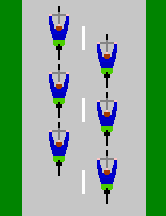The elements that make up matter such as electrons and photons, express dual behavior of a waves and a particle. We could look at these particles as a soliton, a self-reinforcing solitary wave (a wave packet or pulse) that maintains its shape while it travels at constant speed.
Practically you can build a soliton from of a series of free swinging pendula, see professor Kasman's website and picture below:
or these clips:
In regard of Newton's first law, if a soliton with a weak force encounters resistance from the matter trough which it prolongates, the wave can be slowed down, and the linear moving particles could start to curve off and its trajectory bends, like a cotton thread curls over when you dip it deeper into water, or like the curling behaviour of damp.
This could cause the soliton to 'flip over' and bite its tail, making a circle and forming an (8)-ball formation. In such a scenario the lighter particles that make up the (8)-ball would no longer be stopped by the particle in front, or pushed by the one's behind, causing them to be in there own relativity-frame, becoming a new type of element that has its own properties, with a fast or slow frequency spinning/grinding through thick space, like the propeller of ship or the rotors of a mixer generating a surrounding (wave) field, being particle and wave.
The new group of drafting particles would slipstream behind each other, rotating like a 'Belgian tourniquet', in a sea of particles. By bundling their forces and working like a drill, the curled thread in the glass of water becomes a heavy solid object that sinks straight to the bottom, a photon that shooting through space.
The (8) formation generates two opposite fields that are 180° shifted, that IS magnetism, a proton with 3 quarks might be build up out of a 3-way formation causing it to be a stationary object, and in reference to particle collisions, the different particles coming out of the collisions might be different sizes of drills that jet away.






